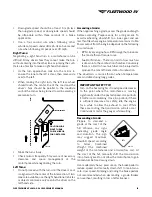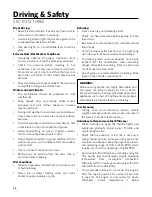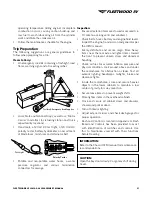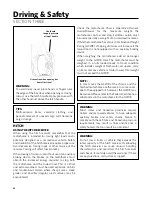
18
Driving & Safety
SECTION THREE
DRIVING TIPS
The motorhome is a
complex
vehicle
that
requires increased driving
awareness
because
of its size and various
components . Turning radius
will be much wider than
that of a standard automobile due to increased length .
Pay close attention to the perimeter of the motorhome
including front, sides, rear, roof and undercarriage . Ensure
the surrounding area is clear of obstacles . Use the mirrors
to observe traffic conditions as well as the exterior
including tires, bay doors, blind spots, etc .
Use a push-pull method of steering, with both hands
parallel on the steering wheel . The motorhome is
considerably heavier than an automobile and has a
higher center of gravity . These factors will necessitate
advanced reaction time . Swerving and sharp cornering
performed high speeds could result in loss of control .
Keep size and weight of the motorhome in mind . Drive
with increased caution to avoid situations that might
require quick momentum changes . Increase reaction
time by paying attention to traffic and road conditions
12 to 15 seconds ahead .
The motorhome will travel safely and comfortably at
highway speed limits . However, it takes more time to
reach highway speed . When passing another vehicle,
allow extra time and space to complete the pass due to
increased length .
Manually shift to a lower gear when descending a long
hill . Begin the descent at a slow speed . Do not allow the
motorhome to gain momentum before trying to slow
down . Use the transmission and engine to help control
downhill speed and can extend the service life of the
brake lining . Distance required to stop the motorhome
is greater than an automobile . Practice stopping away
from traffic to get the feel of distance required to stop .
Note weight limits of bridges before crossing . Signs
should be posted at bridge entrances . Check posted
height of all overpasses and situations where overhead
clearance is limited . Keep in mind road surfaces may
be repaved or packed with snow; therefore, the actual
posted clearance would be less in such conditions .
Use the pilot seat controls to comfortably position
the seat . Stay seated and adjust the outside mirrors if
necessary to gain a clear line of vision down both sides
of the motorhome .
ADJUST TO DRIVING CONDITIONS
Adjusting to road, weather and terrain conditions is
necessary to keep the motorhome under control . Pay
attention to road signs that advise of local road hazards
and driving conditions . Do not operate the motorhome
when road, weather and terrain conditions seem
unsafe .
The cockpit, dash area and windshield are larger than
those found on passenger cars and trucks . Keep the
windshield clear of humidity in the form of water or ice .
Start the motorhome and turn on the dash defrost to
help remove moisture from inside the windshield . It
may be necessary to use a clean cloth to wipe away
moisture . Do not operate the motorhome if the
windshield is not clear .
Keep windshield wipers in good working order at all
times . Do not operate the motorhome when road,
weather and terrain conditions are considered unsafe .
Driving Cautions:
• Avoid getting too close to the shoulder of the road,
which may be too soft to support the weight of the
motorhome .
• Side spacing is best maintained by keeping the
motorhome centered in the driving lane .
• Driving lanes in work zones can be uneven,
congested and more narrow than usual .
• Be cautious of road debris that can damage the
undercarriage of the motorhome or become lodged
in the dual tires and cause damage to the tires,
wheel rims or tow vehicle .
• On back roads and single divided roads, tree
branches and shrubbery can protrude into
the roadway . Watch for low hanging branches
especially during inclement weather . Rain and
snow will cause branches to hang lower than usual .
• Keep in mind that posted speed signs are usually
passenger automobile rated . Be extra aware of
driving conditions and use the appropriate speed
for a motorhome when necessary, especially on
corners and mountain roads .
Summary of Contents for Class A Gas 2020
Page 173: ...FLEETWOOD RV CLASS A GAS 2020 OWNER S MANUAL 171...
Page 174: ...172 Notes...









































